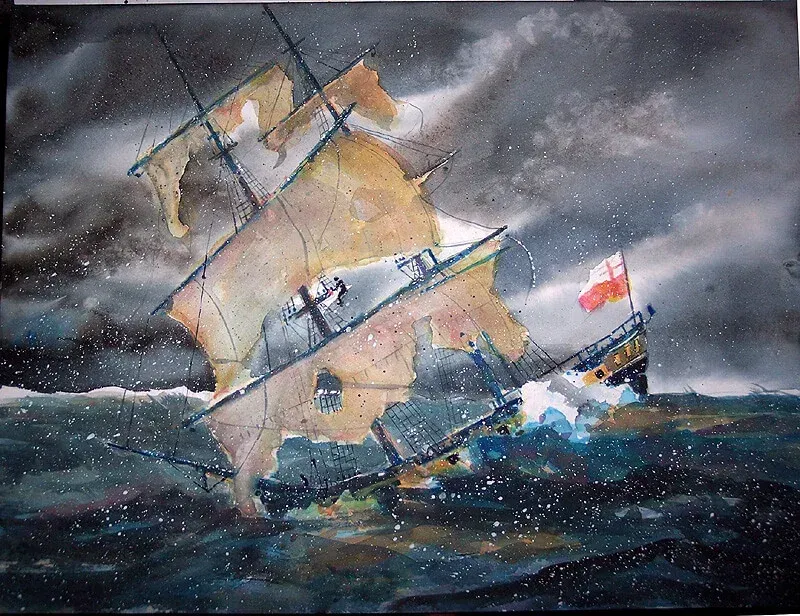
HMS Ontario Shipwreck
Lost since October 31, 1780, enthusiasts Jim Kennard and Dan Scoville discovered the sunken British warship, HMS Ontario.
In June 2008, shipwreck enthusiasts Jim Kennard and Dan Scoville discovered a British warship, the HMS Ontario, off the southern shore of Lake Ontario. The vessel foundered during a sudden storm on October 31, 1780--killing all 120 passengers aboard. Described as “the holy grail” of Great Lakes’ shipwrecks and “an archeological miracle,” the discovery made international headlines. It was officially confirmed “the oldest shipwreck in the Great Lakes and the only known fully intact British warship in those waters.”
Jim Kennard of Fairport, NY began his search for the Ontario in the 1970s. After a few years, he abandoned his search in frustration because he wasn’t a deep-water diver and thus couldn’t fully explore the depths of the lake. He had also started to raise a family. Once his kids grew up and started leaving the nest, he resumed his quest. That’s when Kennard and Scoville teamed up.
In 2002, Kennard “asked the owners [of a local diving shop] if they knew any great divers, and they gave him Scoville’s name. As an avid diver, Scoville would frequent the shop regularly, and he just so happened to walk into the shop minutes later. The two became fast friends.”
Dan Scoville became interested in local shipwrecks growing up in the Rochester, NY area. Scoville, a trained deep diver, learned that the south shore was “good hunting ground” for shipwrecks--especially since there wasn’t much competition.
For 3 years, Kennard and Scoville searched for the Ontario--going back and forth for hours in a slow-moving boat that spanned a search area of over 200 square miles. The team used side-scanning sonar (developed by Kennard himself) and an unmanned submersible to locate and confirm the identity of the wreck.
For 228 years, the Ontario had rested “in an area of the lake where depths exceed[ed] 500 feet.” Sonar images revealed that two of the vessel’s masts remained upright, and some of her anchors, cannons, and guns were still on board. Some of the glass from the six windows in the captain’s quarters remained unbroken. Kennard and Scoville believe that “the cold, freshwater of Lake Ontario, combined with a lack of light and oxygen, delayed decomposition and accounted for the ship being found relatively intact.”
On that fateful Halloween, the 80-foot Ontario was en route to Oswego, NY from Fort Niagara. According to official British records, 74 military personnel, 4 women, 5 children, 4 Native Americans, and 1 civilian were on board when she sank. However, private correspondence from Fort Niagara “indicated that there may have been a total of 120 people on board the ship including about 30 American prisoners.” There were no survivors.
The next day, “some of the Ontario’s boats, hatchway gratings, binnacle, compasses and several hats and blankets drifted ashore in the area that is known today as Golden Hill State Park, located 30 miles east of Fort Niagara in New York State.”
Legend has it that the Ontario also carried $15,000 in gold for the British garrison. Kennard has disputed these claims, stating that the garrison’s pay would have been on the return trip from Carleton Island—the ship’s ultimate destination.
After the Ontario went down, the British conducted an exhaustive search on land and water. They found only the ship’s sails drifting on the lake. “In late July 1781, six bodies from the Ontario were found approximately 12 miles east of the Niagara River near Wilson, NY.”
At the time, the Ontario was the largest and most powerful British warship to sail the Great Lakes. Scoville has acknowledged that “very few warships went down” in those days, making their discovery even more monumental.
It’s estimated that over 4,700 shipwrecks have occurred on the Great Lakes, “including about 550 in Lake Ontario.” To this day, the location of the Ontario remains undisclosed to protect her from looters and to honor her status as a British and American war grave.
In the ensuing years, Kennard and Scoville have discovered even more shipwrecks in Lake Ontario. “The rich history of these boats is what keeps them coming back to knock shipwreck after shipwreck off of their list and make history of their own.”
Hope L. Russell, Ph.D.

